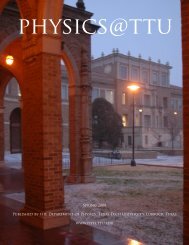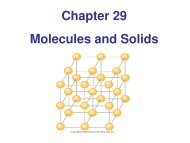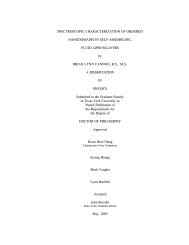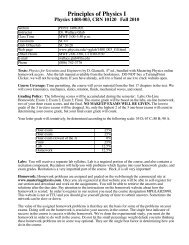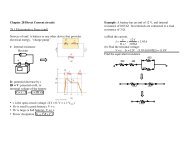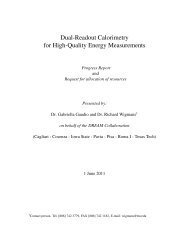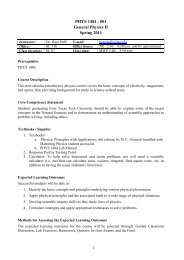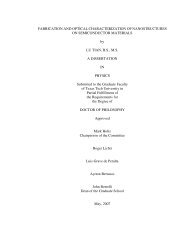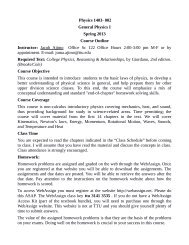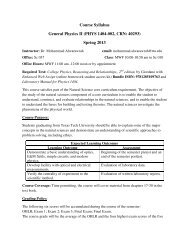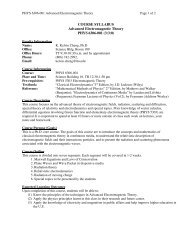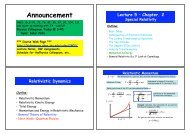Version One â Homework 1 â Juyang Huang â 24018 â Jan 16 ...
Version One â Homework 1 â Juyang Huang â 24018 â Jan 16 ...
Version One â Homework 1 â Juyang Huang â 24018 â Jan 16 ...
Create successful ePaper yourself
Turn your PDF publications into a flip-book with our unique Google optimized e-Paper software.
<strong>Version</strong> <strong>One</strong> – <strong>Homework</strong> 1 – <strong>Juyang</strong> <strong>Huang</strong> – <strong>24018</strong> – <strong>Jan</strong> <strong>16</strong>, 2008 22<br />
The potential difference from O to A is<br />
defined as<br />
∆V = V A − V O = −<br />
∫ A<br />
O<br />
⃗E · d⃗s .<br />
We know that E ⃗ = (250 V/m) î . We need<br />
to choose a path to integrate along. Because<br />
the electric force is conservative, it doesn’t<br />
matter which path we take; they all give the<br />
same answer. There are two choices of path<br />
for which the math is simple (see the figure<br />
below.)<br />
y<br />
E<br />
O<br />
Path I:<br />
II<br />
I<br />
(x, y)<br />
B<br />
A<br />
I<br />
x<br />
which is the same as the result for the other<br />
path.<br />
keywords:<br />
Potential Diagrams 02<br />
25:04, calculus, multiple choice, > 1 min,<br />
wording-variable.<br />
047 (part 1 of 4) 10 points<br />
Consider a sphere with radius R and charge<br />
Q<br />
Q<br />
V A − V O = (V A − V B ) + (V B − V O ),<br />
From O to B, ⃗ E and d⃗s are both along the<br />
x-axis, so ⃗ E · d⃗s = E dx. From B to A, ⃗ E and<br />
d⃗s are perpendicular, so ⃗ E · d⃗s = 0.<br />
and the following graphs:<br />
∝ 1 r<br />
∫ B<br />
V A − V O = −<br />
= −<br />
= −E<br />
O<br />
∫ x<br />
0∫ x<br />
O<br />
⃗E · d⃗s −<br />
E dx −<br />
∫ A<br />
B<br />
∫ y<br />
0<br />
0 dy<br />
dx = −E ∆x<br />
= −(250 V/m) (0.2 m)<br />
= −50 V .<br />
⃗E · d⃗s<br />
Q.<br />
G.<br />
0<br />
R<br />
∝ 1 r<br />
r<br />
The absolute value is<br />
|∆V | = 50 V .<br />
0<br />
R<br />
r<br />
Path II: In this case, E ⃗ · d⃗s = E cos θ ds .<br />
where cos θ = x ⇒ x = l cos θ .<br />
l<br />
∝ 1 r 2<br />
∫ l<br />
V A − V O = −E cos θ ds<br />
O<br />
= −E l cos θ<br />
= −E x .<br />
X .<br />
0<br />
R<br />
r



